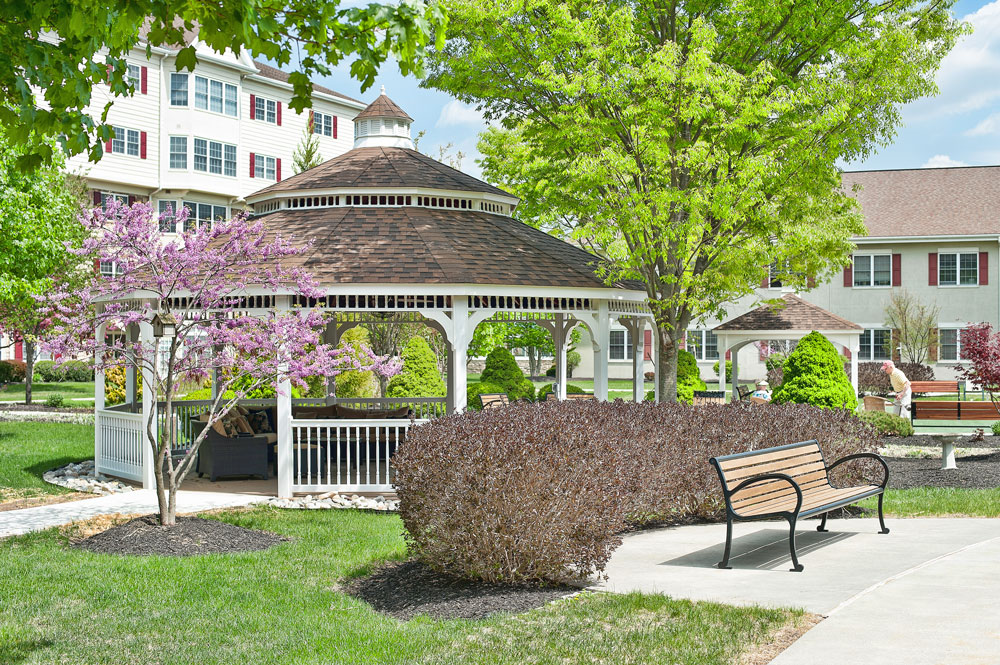How to Decorate a Memory Care Room

If you’re assisting a loved one with their move to a memory care apartment, you’ll likely want to make it as warm and comforting a setting as possible. With the right dementia-friendly design, you can create a space that could encourage better days for your loved one. To help you begin, we’ve outlined some of the most helpful memory care decorating ideas for their new apartment.
Memory Care Decorating Ideas
Bring in Familiar Items
Photos of loved ones, long-held furnishings, even a favorite chair can instantly help the space feel more like home and help your loved one feel a sense of ownership of their residence. Photos can help spark conversation and connection with visitors and caregivers, so choose meaningful images of people with whom your loved one had a strong relationship or snapshots from important moments in their life.
Heighten Contrast
Normal aging can cause the lenses in the eyes to thicken and yellow, which reduces seniors’ ability to detect subtle contrasts in their environment. It may also desaturate the look of colors, softening even the brightest hues. For those with dementia, this blending of colors can lead to more confusion and disorientation. When selecting items for a dementia-friendly design, look for every opportunity to create a strong contrast with solid colors to help create an easily understandable space. For example, you might place a brown chair in front of a white wall.
Limit Busy Patterns
People with dementia may perceive strong patterns as moving objects. Additionally, while contrast between a solid-color object and its surroundings can help the object stand out for the person with dementia, strongly contrasting patterns, like black and white checks, on furniture or surfaces can become confusing. Darker parts of the pattern may look like they have more depth than lighter sections, leading to complications and uncertainty. Try to stick to solid colors for furnishings and finishes.
Skip the Throw Rugs
Throw rugs can become an unnecessary tripping hazard. While the traction of a rug is better for stability than slippery hardwood floors, unadorned carpet is ultimately the best choice for the resident’s safety.
Create a Comfortable, Clear Flow
Arrange furniture so there are open walking areas and clear floor space; always be sure to remove any trip or slip hazards. Signs around the home, such as a cute bathroom sign on the bathroom door, can also help minimize your loved one’s confusion, promoting a comfortable flow.
Light It Well
According to the Dementia Services Development Center, people over age 75 require two times more light than the recommended standard to see satisfactorily. And people living with dementia require even more attention paid to lighting – they’re served best by even lighting throughout a room. Dark or shadowed areas may be seen as threatening or ominous. Natural light is another important consideration in dementia care. Windows can help your loved one stay better attuned to their circadian rhythms. “Sundowning” can be a symptom of time confusion caused by various types of dementia. Individuals in mid to late stages of the condition may become more confused and agitated later in the day, as the sun is setting. Natural light can help keep their body on a regular schedule and can temper some of the effects of sundowning.
Routines and Reminders
Make signs, labels and symbols part of your family member’s home décor to help them easily find and recognize the purpose of a drawer, closet or cabinet. Also, make sure all items are stored where the average person would expect them to be. For example, sheets and towels in the linen closet and dry goods in the pantry.
Create Shadow Boxes
Fill a shadow box – or several shadow boxes – with mementos that are important to your loved one and/or represent who they are. These display cases can house your loved one’s more breakable items, so they can still enjoy them. And if you create a shadow box that represents their life, the team members in a community will have a fuller picture of your loved one’s personality, the kinds of things they like and the sort of life they’ve lived. All these clues can help caregivers get to know your loved one quicker and form a stronger bond with them.
Stand Out
Distinguishing your loved one’s home from the other residences in the community by using features that act as landmarks, such as familiar items outside the entrance or a festive wreath or photo on their door.
Design a Multisensory Experience
Offering people with dementia a greater variety of sensory and motor activities can enrich their everyday experience. There are many sensory room ideas for dementia. For example, you may provide a room spray of one of their favorite scents. You could put items in drawers that are safe but stimulating, like colorful pom-poms, a spiky massage ball or boxes of dried rice or pasta. You could include a soothing sound machine in the room.
At Our Community, All Care is Personal
At Freedom Village at Brandywine our memory care neighborhood features person-centered care that’s customized to your loved one’s unique needs. An important part of our care is an innovative program called Heartfelt CONNECTIONS – A Memory Care Program™. To explore whether our memory care community is right for your loved one, use our Community Assistant chat feature or contact us here.




